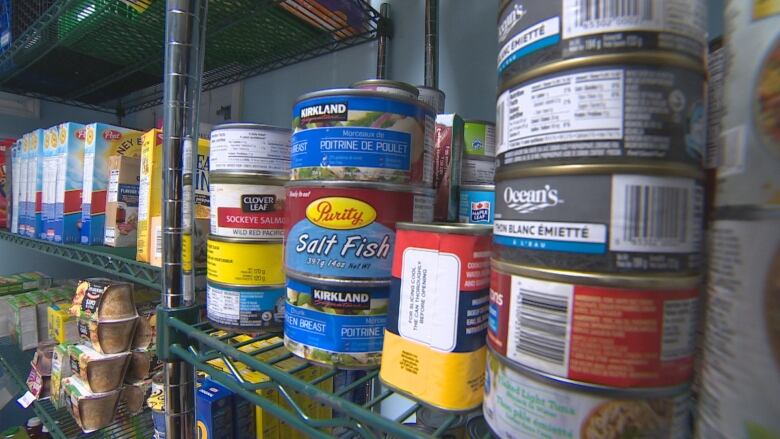N.L. food banks are seeing increased demand and operators blame the rising cost of living
COVID-19, high grocery prices and other factors are 'snowballing,' says one food bank manager

Newfoundland and Labrador food bank operators say they blame the soaring cost of living and high food prices for arise in new clients.
David Harvey, ministry lead for the Salvation Army food bank in Port aux Basques, says since Christmas, he's started seeing more new clients and returning clients who hadn't availed of the food bank in a year or more.
"With costs and the way things are, people are finding it really difficult to make ends meet anymore," he told CBC News on Monday.
Harvey said the food bank serves about 75 to 100 families a month in Port aux Basques, a community of about 4,000, and the surrounding areas. He said the food bank has signed up five or six new clients in the past couple of weeks, an unusually high number, as the cost of living rises.
He pointed to the difficulty of paying for things like rent, a mortgage, gas, food, clothing, child care and schooling while making low or minimum wages. He said he doesn't believe the need for food banks will ever dissipate, but a higher minimum wage could help.
"We could bring that part up to a reasonable wage, a working wage and, you know, that may eliminate some of those issues."
The impact of COVID-19
Harvey said COVID-19 and its impact on businesses play a role in the demand on the food bank, as some employees see their income slashed.
"Businesses can't afford it anymore, to keep full staff," he said. "So now they're down to maybe half days or one day or two days a week versus maybe three or four days prior to this."
Jill Elson, community outreach worker for the Labrador Friendship Centre, co-ordinates the food bank servingthe Upper Lake Melville region andSheshatshiu. In January, she said, the food bank served 118 households in the Upper Lake Melville area and 10 families in Sheshatshiu.
Elson said demand has been rising at the food bank since the fallbut jumped during the COVID-19 outbreak in late December. She said some families had to avail of the food bank because they couldn't work while in quarantine.
"It's just a hard time trying navigate the whole isolation period. Sometimes they won't be getting paid while they're off," she said.

Elson noted the price of food especially fruit and vegetables is higher in Labrador than in the rest of the province.
"Trying to juggle the every day family bills and all thatstuff and trying to keep food on the table, the community's definitely feeling that extra strain," she said.
The 'hungry month'
Tracy Dawe, the manager of the Interfaith Goodwill Centre in Lewisporte, said the number of families coming to the food bank at the centre has been rising since October, and has gone up even faster this month.
Dawe said the increased demand is due to a number of factors, including the rising cost of living, low wages and myriad impacts of COVID-19. According to Dawe, the number of clients availing of the food bank stayed relatively stable during the first year of the pandemicbut is now going up.
"It's all snowballing and now people are starting to see, you know, the major effect of it," she said.
She said the food bank struggled to keep up when its thrift store closed while the province was in Alert Level 4, but local churches helped out with food drives.
"We're trying to run as tight a ship as possible so we can meet the demands," Dawe said. "We've been successful in doing so up to now."
Dawe said March is the "hungry month," as many of the donations from Christmas have dried up, leaving some struggling to get through the end of winter.
"At Christmastime everybody is giving, but then after March, the same people that needed Christmastime also need throughout the year."
Demand could increase more
Peter Wells, the chair of the C.B.S.-Paradise Community Food Bank, said between 400 and 450 families are using the food bank each month, up from 300 families this time last year. He said he expects the number of families using the food bank to keep going up.
Wells said donations are down, and he blames the decline on the rising cost of food.
"People just can't afford it anymore," he said.

Susan Halley, the chair of Emmaus House, a food bank operated by five St. John's-area churches, said theygiveout about 400 hampers a month. She said the food bank hasn't seen an overall increase in clients this year so far, butbased on data from the Community Food Sharing Association, willlikely see a 20 per cent increase in clients in 2022.
That increase in clients, coupled with the increase in the cost of groceries, has led the food bank to increase its budget by 30 per cent. Halley said EmmausHouse hopes a combination of church contributions, fundraisers and grants will meet the additional need.
"When [they] have to decide, 'Do I keep the lights on or do I get the groceries' because all of it's going up unfortunately, they have to pay their bills, and they come to the food bank."












_(720p).jpg)


 OFFICIAL HD MUSIC VIDEO.jpg)
.jpg)



























































































